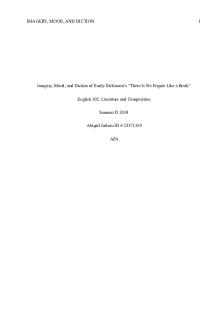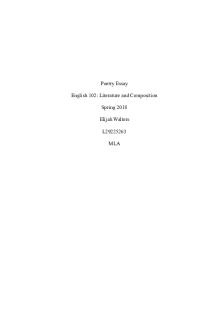Poetry Essay - Grade: A+ PDF

| Title | Poetry Essay - Grade: A+ |
|---|---|
| Author | Andrew Lisa |
| Course | College English Ii |
| Institution | Seton Hall University |
| Pages | 5 |
| File Size | 68.6 KB |
| File Type | |
| Total Downloads | 43 |
| Total Views | 167 |
Summary
The Slipping Away of a Son: The Mother of the Groom’s Perspective...
Description
Lisa 1 Andrew Lisa Dr. Sanyal English 1202 26 February 2020 The Slipping Away of a Son: The Mother of the Groom’s Perspective Often in the form of song or oral dissertation, poetry has been utilized to articulate complex emotional states in an array of cultures throughout history. The deep feelings expounded upon within poetry are expressed in an artistic form absent in other types of literature. The methods by which poets present their ideas frequently include syntax, organization of stanzas, diction, and a variety of rhetorical devices. In his poem Mother of the Groom, Seamus Heaney uses third-person narration and rhetorical devices such as symbolism and irony to highlight the bittersweet feelings a mother experiences on the wedding day of her son. In order to illustrate the emotions of the reminiscing mother, Heaney employs a third person narration technique throughout the poem. It can be determined from the title of the poem that the woman whose thoughts which the narration describes is in fact the mother of the groom. Heaney’s use of third person narration not only allows the reader to see the mother’s memories, but also her emotional response through the visualization of her body language. Within the second stanza, the narrator says, “Hands in her voided lap,/ She hears a daughter welcomed” (Heaney 871). Since the mother is thinking back on when her son was younger, Heaney’s use of the phrase “voided lap” refers to when her son was young enough to sit in his mother’s lap. Now instead the mother’s hands fill the emptiness of her lap, accentuating the new reality that her son is moving on and no longer dependent on her. An initial view of this stanza leaves the reader
Lisa 2 questioning the mother’s opinion of her son’s marriage, but upon finishing the final line, “In her clapping hand,” it is clear that she is in fact glad. By using this style of narration, Heaney simultaneously displays the mother of the groom’s memories and her feelings towards her son’s marriage. In addition to writing style, Heaney uses a repetition technique with evolving connotations to symbolize the many emotions which the mother of the groom is experiencing. An example of such a symbol is the actions of the mother’s hands. In the first stanza, the mother is remembering back to when she would bathe her son as a toddler, where her hands are presumably holding him while she washes him. This hold symbolizes the son’s dependence on his mother during his early stages of life, where he could not so much as wash himself. Presently sitting at the wedding ceremony, the mother’s hands are folded idly in her lap. The sons departure from dependence on his mother is described by the narrator in saying, “It’s as if he kicked when lifted/ And slipped her soapy hold,” symbolizing that his mother no longer has a secure hold on him as part of her life (Heaney 871). In the last line, the mother’s final perspective on her son’s wedding is revealed when her hands are clapping during the conclusion of the ceremony. While she is sad to see her son leave her grasp, she is undoubtedly rejoicing with her son and his bride on their wedding day. Other examples of symbolism throughout the poem, in addition to the mother’s hands, includes rings which are used by Heaney to represent commitment. In the first stanza a “ring of boots” is mentioned as the mother is bathing her son (Heaney 971). This ring symbolizes the mother’s commitment to raising and caring for her son in a loving manner for as long as he needs her. In the last stanza, a ring is again mentioned, but this time as a wedding band around the groom’s finger. In this case, the ring still represents a commitment of love, but it is between the
Lisa 3 son and his bride. The contrast between that which each of these commitments represent further emphasizes the clashing bittersweet feelings which the mother has regarding her son’s wedding day. An additional rhetorical device utilized to emphasize the mother’s emotional state is Heaney’s use of irony in his closing stanza. This irony is an overview of the mother’s emotional journey through the poem. Heaney writes: Once soap would ease off The wedding ring That’s bedded forever now In her clapping hand (Heaney 871). Wedding rings symbolize the covenant of marriage between a husband and a wife to stay together for the rest of their lives. This covenant includes the promise that the couple will work together to raise and provide for children of their own in the coming years. This simultaneously connects the mother’s wedding ring to her love for her son and her memories of bathing him when she would remove her rings in order to do so, which is an act of care for him. The mother is now at the end of this part of her own promise related to her marriage, where her son is finally moving forward in making his own covenant in marriage. The irony exists between the fact that the mother used to use the soapy water to take her wedding ring off of her hand while she gave her son a bath, but now a wedding ring on her son’s hand is symbolizing his binding covenant to his wife which cannot be broken by simply removing the ring. This epitomizes the conflicting emotions the mother has, where she is sad as she reminisces on memories with her son but also is hopeful that his marriage will be successful and lifelong as it is intended to be.
Lisa 4 In his poem Mother of the Groom, Seamus Heaney uses third-person narration and rhetorical devices such as symbolism and irony to highlight the bittersweet feelings a mother experiences on the wedding day of her son. Not only does his poetic approach illustrate the story which he is telling, but it also manages to capture the complex emotions which the mother experiences. While effectively expressing emotions proves difficult, poetry is often used to do so not via denotation, but through the transcendence of the words themselves.
Lisa 5 Works Cited Heaney, Seamus. “Mother of the Groom.” The Norton Introduction to Literature 10th Edition, edited by Peter Simon, W.W. Norton and Company, 2010, p.p. 871....
Similar Free PDFs

Poetry Essay - Grade: A+
- 5 Pages

Essay Poetry - Grade: A
- 3 Pages

Poetry Essay - Grade: 80%
- 6 Pages

Poetry Essay - Grade: B
- 5 Pages

Poetry Paper 2 - Grade: a
- 7 Pages

Capstone essay - Grade: A+
- 10 Pages

Nutrition Essay - Grade: A
- 4 Pages

Abortion (Essay) - Grade: A
- 4 Pages

Essay 2 - Grade: A-
- 4 Pages

Othello Essay - Grade: A+
- 2 Pages

Coraline Essay - Grade: A-
- 3 Pages
Popular Institutions
- Tinajero National High School - Annex
- Politeknik Caltex Riau
- Yokohama City University
- SGT University
- University of Al-Qadisiyah
- Divine Word College of Vigan
- Techniek College Rotterdam
- Universidade de Santiago
- Universiti Teknologi MARA Cawangan Johor Kampus Pasir Gudang
- Poltekkes Kemenkes Yogyakarta
- Baguio City National High School
- Colegio san marcos
- preparatoria uno
- Centro de Bachillerato Tecnológico Industrial y de Servicios No. 107
- Dalian Maritime University
- Quang Trung Secondary School
- Colegio Tecnológico en Informática
- Corporación Regional de Educación Superior
- Grupo CEDVA
- Dar Al Uloom University
- Centro de Estudios Preuniversitarios de la Universidad Nacional de Ingeniería
- 上智大学
- Aakash International School, Nuna Majara
- San Felipe Neri Catholic School
- Kang Chiao International School - New Taipei City
- Misamis Occidental National High School
- Institución Educativa Escuela Normal Juan Ladrilleros
- Kolehiyo ng Pantukan
- Batanes State College
- Instituto Continental
- Sekolah Menengah Kejuruan Kesehatan Kaltara (Tarakan)
- Colegio de La Inmaculada Concepcion - Cebu




